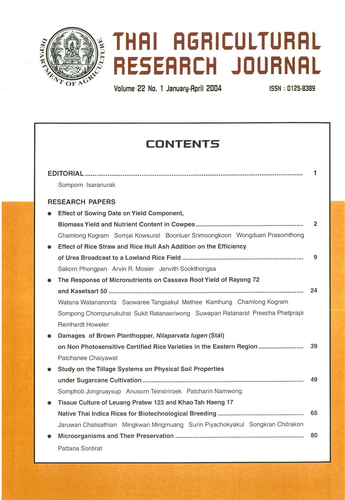The Response of Micronutrients on Cassava Root Yield of Rayong 72 and Kasetsart 50
DOI:
https://doi.org/10.14456/thaidoa-agres.2004.3Keywords:
micronutrients, Rayong 72, Kasetsart 50Abstract
Cassava has been growing in Thailand, resulting in a decrease in the soil’s micronutrient content due to crop removal and soil erosion. Symptoms of Zn deficiency in upper leaves are now often occured, especially in the calcareous soils. Three experiments were conducted to determine the response of Cassava varieties namely Rayong 72 and Kasetsart 50 to micronutrient. The rate and method of four micronutrients had an significant and effect on fresh root yield but not on starch content from the first experiment. The application of 0.8 Kg Zn/rai to the soil and soaking the cutting in 2% ZnSO<sub>4</sub>7H<sub>2</sub>O for 15 minutes before planting gave the highest fresh root yield of 4,579 and 4,567 kg/rai and starch content of 27.9 and 26.6%, respectively. Then, the second experiment was conducted to determine the most effective method and rate of applications of Zn to the same two varieties. Highest yields were obtained with three foliar applications of 4% ZnSO<sub>4</sub>7H<sub>2</sub>O 1,2 and 3 months after planting. The treatment was 243 baht/rai made an income of 685 baht/rai. It should be recommended to farmers in the areas where Zn deficiency has been a serious problem in cassava growing from the second experiment. The third experiment indicated that the various treatments on rate and method of specificed micronutrients had no effect on fresh root yield and starch content at Maha Sarakham, Roi Et and Ubon Ratchathani provinces respectively The response of micronutrient on fresh root yield of Rayong 72 was higher than Kasetsart 50. It was found that the symptoms of Mg deficiency had been shown in lower leaves at Kalasin province.
Downloads
Published
How to Cite
Issue
Section
License

This work is licensed under a Creative Commons Attribution-NonCommercial-NoDerivatives 4.0 International License.
Thai Agricultural Research Journal



